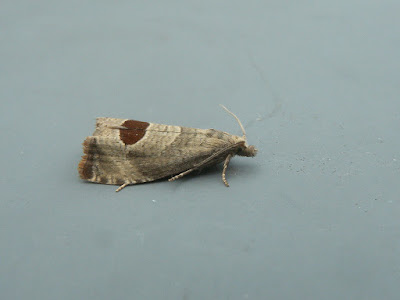Some more moths from the trap last night. Firstly, this Bramble Shoot Moth Notocelia uddmanniana, one the easiet of our micromoths to identify with the very distinctive chocolate brown blotch on the joined forewings. Unsurprisingly, the larval foodplant is bramble (Rubus).
 |
| Bramble Shoot Moth Notocelia uddmanniana |
How about this Clouded Silver Lomographa temerata, surely a contender for one of the smartest moths on the wing right now.
 |
| Clouded Silver Lomographa temerata |
Then there was a Clouded-bordered Brindle Apamea crenata. The name may be a bit of a mouthful, but the subtle colours and patterns make this a rather nice moth. It is a species whose caterpillars feed on grasses, a good reason for people to leave more of lawns and verges uncut.
 |
| Clouded-bordered Brindle Apamea crenata |
I regularly catch Coleophora species in my garden, but usually let them go straight away. This large family of micromoths is notoriously difficult to identify as adults, with the cases on foodplants being a better guide. However, as a rule, anything that looks shiny and furry is worth a check. So a Coleophora with shiny green wings and a furry base to the antenna caught my eye. This is Coleophora mayrella, a species of grassy areas. The larvae feed on White Clover Trifolium repens, which now grows in abundance in my garden.
 |
| Coleophora mayrella |
Finally a Pebble Prominent Notodonta ziczac, a long awaited garden first and a species with one of the best scientific names.
 |
| Pebble Prominent Notodonta ziczac |
No comments:
Post a Comment